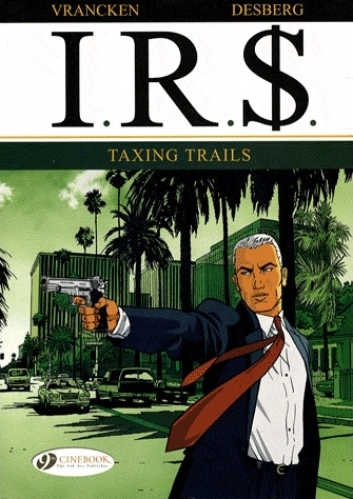Review by Roy Boyd
This book contains two volumes as originally published in Europe, Taxing Trails and The Hagen Strategy, the first and concluding parts of a story that introduces us to Larry B. Max, an agent who works for the I.R.S., the USA’s tax department. Although it’s safe to say that Larry is probably quite unlike any tax collector or investigator you’ve ever seen, or imagined as on a daily basis he’s involved in as many shootouts as Dirty Harry.
We open with a brief introduction to the glamorous lifestyle that our hero enjoys as he dresses for the evening. The story’s supposed to be cutting-edge and hi-tech. However, the problem with portraying anything cutting-edge is that the edge moves so quickly. While the Nokia phone on the first page might have been state of the art in 1999, it now looks almost as dated as Tintin’s plus fours. Heading out, our protagonist stops at a grocery store to buy champagne, only to become embroiled in a stick-up. This gives him the chance to show that he’s both invincible and unflappable, and is something of a genre cliché.
Writer Stephen Desberg weaves a great deal of historical fact into his tale of missing Jewish millions, banked in Switzerland and held onto by greedy bankers who knew only too well that documentation wouldn’t exist for most of the Holocaust victims and survivors. It’s probably not too much of a plot spoiler to reveal that the story may well involve some nasty Nazis too. Desberg should be applauded for bringing to light one of the many sorry episodes from what was undoubtedly the darkest period in human history. The plot hangs together fairly well, though some developments are a obvious, and the reader will likely find that they see stuff coming long before our supposedly Sherlock Holmes-like hero does.
Much like the writing, Bernard Vrancken’s artwork is okay, verging on good, which might be damning with faint praise, but the standards in comics are so high now that anything less than stellar often looks amateurish. It’s clear that a great many photos have been used as references, and one never doubts the verisimilitude of the settings. Sadly, the same isn’t true of the figurework, with many poses and expressions very stiff, and sometimes really unconvincing. This problem is especially noticeable in action scenes that are often poorly depicted, whether the viewpoint is from such a distance that one can’t see what’s going on, or just laid out so badly that one has to guess at what’s happening.
The series, in French, now includes at least twenty volumes, and it may well improve as the stories become more contemporaneous, but on the evidence of this first book it’s a fairly enjoyable and slightly dated international espionage tale that’s nothing remarkable in execution: one for the accountants in your life, perhaps.
The format of this book, with both volumes together, is satisfying as it contains the entire story. Though a word of warning is the inside pages of my copy had separated from the spine before I’d turned more than a few pages, which isn’t great. Blue Ice continues the series.





